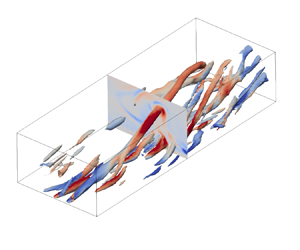Article contents
Effects of streamwise rotation on helicity and vortex in channel turbulence
Published online by Cambridge University Press: 08 February 2024
Abstract

Helicity plays a key role in the evolution of vortex structures and turbulent dynamics. The helicity dynamics and vortex structures in streamwise-rotating channel turbulence are discussed in this paper using the helicity budget equation and the differentiated second-order structure function equation of helicity. Generally, rotation and Reynolds numbers exhibit opposing effects on the interscale helicity dynamics and the vortices. Under the buffer layer, the positions of the helicity peaks are proportional to the ratio between the Reynolds and rotation numbers. The mechanism is related to the opposing effects of convection and rotation. Rotation directly affects the helicity balance through the Coriolis term and corresponding pressure term. In the buffer layer, the scale helicity is negative at small scales but positive at large scales, which is mainly induced by the spatial effects (the production and the spatial turbulent convection) but reduced by interscale cascades. Examination of structures reveals the close association between scale helicity and streaks, with streak lift angles exhibiting an increase with rotation and a decrease with Reynolds numbers. In the log-law layer, the Coriolis terms and corresponding pressure terms are proportional to the rotation numbers but remain independent of the Reynolds numbers. The negative scale helicity is forward cascaded towards small scales. Generally, spanwise vortices in the log-law layer are related to sweep events and forward cascades. Our findings indicate that these spanwise vortices are suppressed by rotation but recover with increasing Reynolds numbers, aligning with the effects observed in the scale helicity balance.
- Type
- JFM Papers
- Information
- Copyright
- © The Author(s), 2024. Published by Cambridge University Press
References
- 1
- Cited by



